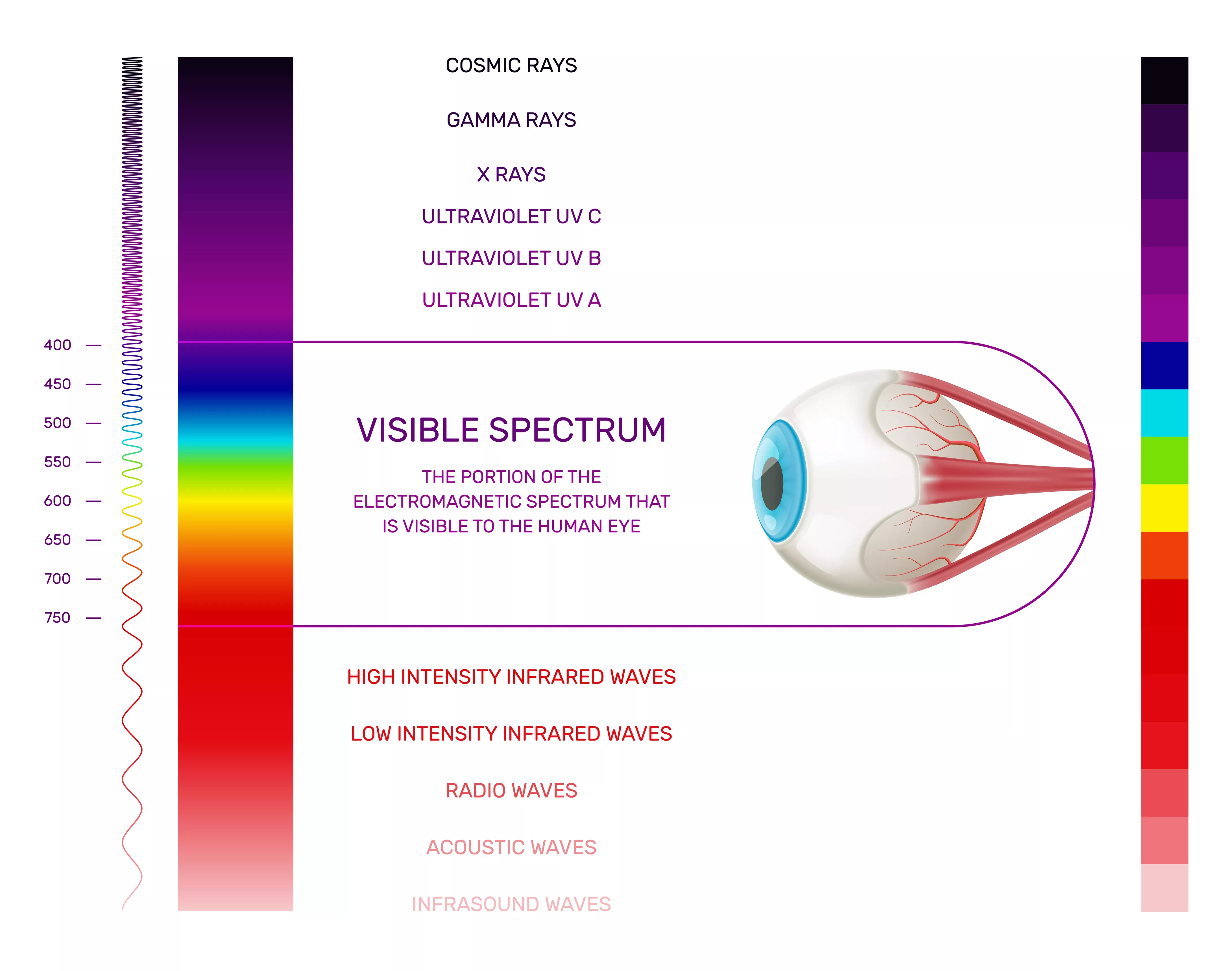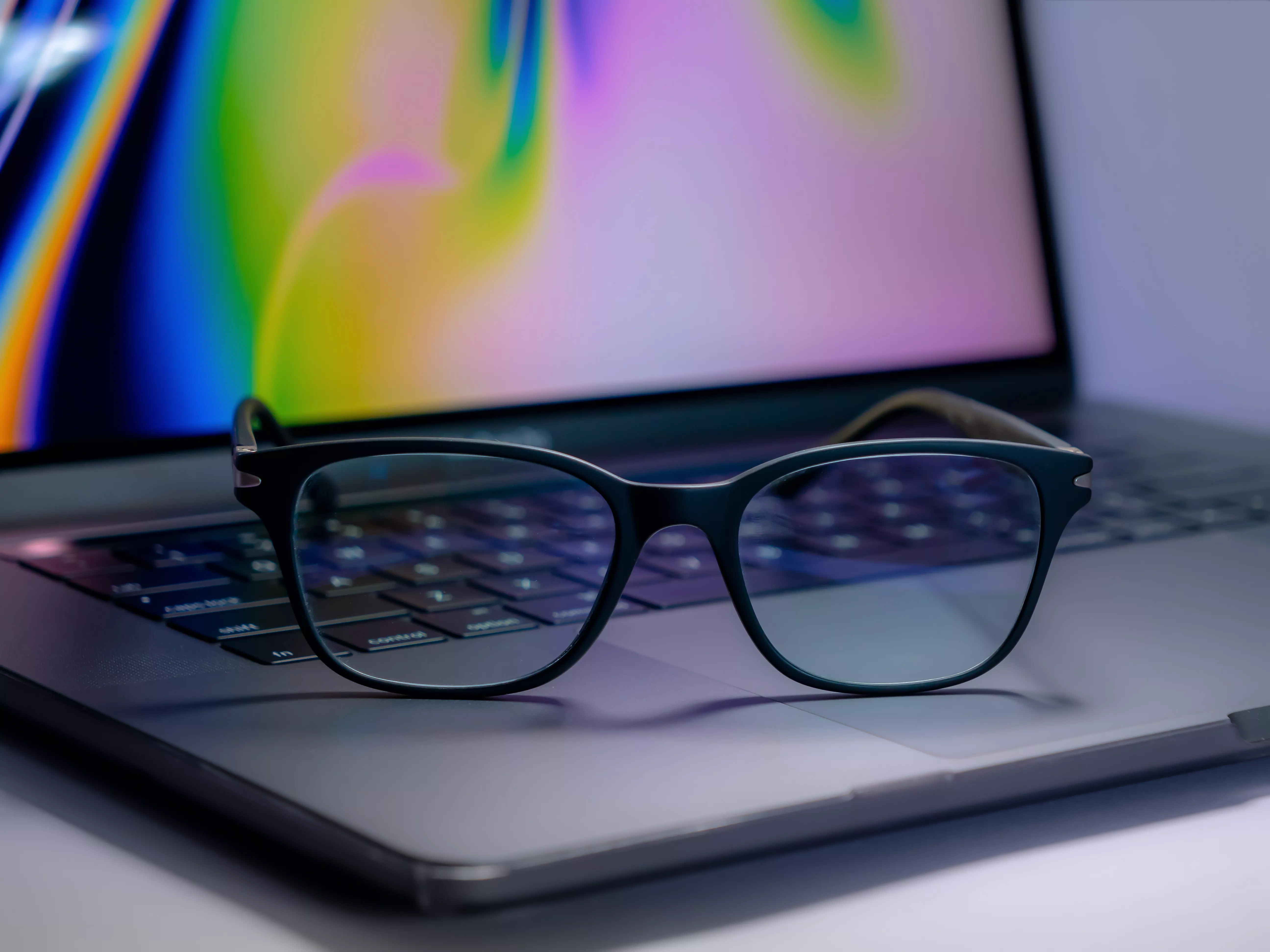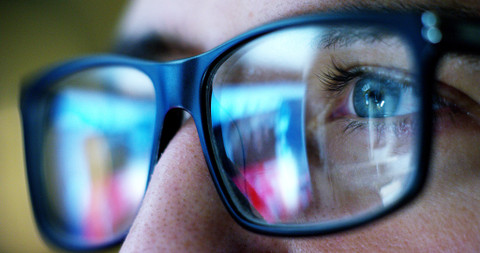With more people than ever working from home and parents turning living rooms into classrooms, the use of computers has increased dramatically. Although working from home can be a great way to increase your flexibility and save money on gas, increased screen time means higher exposure to blue light. But just how damaging is blue light to your eyes, and should you invest in blue light glasses to help limit your exposure? Find out everything you need to know and more.
• What is blue light?
• How can blue light damage your eyes?
• What is the connection between blue light and sleep?
• Can blue light harm or help my mental health?
• What is digital eye strain?
• What causes digital eye strain?
• How is digital eye strain diagnosed?
• Do blue light blocking glasses work?
• What are the benefits of blue light glasses?
• Can you buy blue light contacts?
• How do I prevent digital eye strain?
What is blue light?
Our eyes see colors based on the visual light spectrum, a concept you probably know as
ROY G BIV. Each letter in the acronym stands for the name of a color:
• Red
• Orange
• Yellow
• Green
• Blue
• Indigo
• Violet
When the colors come together, they create the white light you see from the sun. Blue light is given off by electronic devices such as your laptop, iPad or tablet, smartphone, and flatscreen television. The good news is that blue light can help boost your mood, increase alertness, improve your memory, and expand your reaction time and attention span. Unfortunately, too much exposure to blue light can have a negative impact on your health.
Every color we can see in the visible light spectrum has a different energy level and wavelength. Blue light has higher energy and shorter wavelength than other colors in the spectrum. According to WebMD, research shows a link between show-wave blue lights, light with wavelengths between 415 and 455 nanometers, and eye damage. The majority of LEDs in televisions, smartphones, and tablets produce wavelengths between 400 and 490 nanometers.
How Can Blue Light Damage Your Eyes?
The concept that ultraviolet rays, also known as UV rays, can be harmful in large amounts is well known. Doctors recommend frequently applying sunscreen, wearing covering clothing and a wide-brimmed hat, limiting your overall sun exposure during peak daylight hours, and protecting your eyes with sunglasses as ways to reduce your risk of eye and skin damage from UV rays from the sun.
 We already know that ultraviolet and blue light rays from the sun can increase a person’s risk of developing eye disease. Experts have also raised concerns about the risks associated with high exposure levels from blue lights within digital screens. So far, there have been mixed responses from eye care professionals across the world, with some stating that blue light glasses aren’t necessary and others recommending them to their patients who are dealing with digital eye strain and frequent screen use.
We already know that ultraviolet and blue light rays from the sun can increase a person’s risk of developing eye disease. Experts have also raised concerns about the risks associated with high exposure levels from blue lights within digital screens. So far, there have been mixed responses from eye care professionals across the world, with some stating that blue light glasses aren’t necessary and others recommending them to their patients who are dealing with digital eye strain and frequent screen use.
According to a reference article by WebMD on the impact of blue light on your health,
Research shows that blue light can damage the retinas through a process called phototoxicity. The amount of damage that occurs depends on the exposure time and the wavelength of the light. “Animal studies show even short exposure (a few minutes to several hours) may be harmful.” A blue light blocking filter that reduces the amount of blue light by 94% has been shown to decrease the damage.
Additional evidence states that it is possible that high amounts of blue light exposure can lead to permanent vision damage. Because nearly all blue light passes directly through the eye to the back of the retina, there is reason to believe that frequent exposure to blue light may increase a person’s risk of age-related macular degeneration. This condition, also known as AMD, impacts the retina and can cause a complete loss of vision. One research study showed that exposure to blue light caused photoreceptor cells to release toxic molecules, damaging the retina and leading to AMD.
What is the Connection Between Blue Light and Sleep?
Exposure to blue light, particularly at night, can disrupt your body’s circadian rhythm, also known as your sleep cycle. The blue light from digital screens triggers your brain to feel more awake rather than rest. This disruption can cause poor sleep quality, which can prevent your eyes, and your body as a whole, from engaging in the regenerative practices needed to heal injuries and prevent disease. One study showed that only two hours of blue light exposure slowed or completely stopped the production of melatonin, also known as the sleep hormone.
Can Blue Light Harm or Help My Mental Health?
Animal studies also showed that another result of blue light exposure in the evening was an increased risk of symptoms of depression. On the contrary, however, daytime exposure to blue light can help improve symptoms of seasonal affective disorder, also known as SAD. This condition impacts people’s moods during seasonal changes, and using blue light therapy for 20 minutes in the morning has been shown to reduce symptoms of SAD in affected individuals.
What Is Digital Eye Strain?
According to the North Carolina Optometric Society, “the average American worker spends seven hours a day on the computer either in the office or working from home.” Digital eye strain, also known as computer vision syndrome, is a collection of vision-related conditions resulting from frequent and prolonged use of digital devices, including tablets, computers, cell phones, and e-readers. Experts believe that computer vision syndrome, also known as digital eye strain, impacts roughly 50% of computer users.
People report experiencing vision problems and eye discomfort after using digital devices for extended lengths of time. These problems can include:
• Headaches
• Dry eyes
• Neck stiffness
• Blurry vision
• Eyestrain
• Shoulder pain
How severe a person’s symptoms are typically depends on their length of exposure and whether they have existing visual conditions, especially ones that have not been corrected. Vision conditions such as astigmatism, farsightedness, presbyopia, and problems focusing the eyes can all increase the impact blue light has on them.
What Causes Digital Eye Strain?
 Eye strain can occur as a result of several different activities, not just exposure to blue light. Like any part of our body, overuse can cause fatigue. The eyes are no exception. In addition to staring at digital devices and screens, driving long distances and reading for long periods causes our eyes to work overtime.
Eye strain can occur as a result of several different activities, not just exposure to blue light. Like any part of our body, overuse can cause fatigue. The eyes are no exception. In addition to staring at digital devices and screens, driving long distances and reading for long periods causes our eyes to work overtime.
In addition to frequent general exposure to blue light and other triggers, digital eye strain can be triggered or made worse by:
• Glare on the digital screen a person is viewing
• Poor posture
• Poor ambient lighting
• Viewing a screen too close or from too far away
• A combination of multiple contributing factors
How Do You Diagnose Digital Eye Strain?
Most people who experience digital eye strain find that their symptoms are mild and often resolve themselves without treatment from an eye care provider. Decreasing screen time, correcting posture and lighting, and adjusting contributing vision issues often significantly improve symptoms. However, some people may continue to experience digital eye strain symptoms even after taking proactive steps to resolve them. In this case, experts advise that the issue will continue to present itself and possibly worsen with screen use in the future if the cause isn’t addressed.
An eye care professional can make an official diagnosis of computer vision syndrome after conducting a
comprehensive eye exam. In addition to a test of the patient’s eyesight, the doctor may conduct additional screenings, including:
• A comprehensive visual history from the patient, including any general health issues, environmental factors, medications, or other factors that may contribute to the symptoms they’re experiencing.
• A refraction test to determine if the patient has any refractive errors that need to be addressed, such as astigmatism, farsightedness, or nearsightedness.
• Measuring visual acuity to determine how extensively the patient’s vision is impacted.
• Testing how the eyes move, focus, and work together. Creating an accurate image for the brain to interpret involves the eyes working in unison. Eyes that struggle to work together and focus effectively can cause symptoms of digital eye strain.
An eye care professional may perform these vision tests with or without eye drops that impact the eyes’ ability to focus. A doctor may want to observe how the eyes react under normal circumstances but may also recommend using eye drops that prevent the eyes from refocusing to conduct specific tests. After reviewing all of the information and test results, the doctor will then determine if a diagnosis of computer vision syndrome is appropriate and create a treatment plan.
Do Blue Light Glasses Work?
If you want to know whether blue light glasses work, the answer will depend on who you ask. As we discussed earlier, multiple triggers can cause or worsen digital eye strain symptoms, and there are also several ways to treat the condition. The one similarity to most of the treatment plans for computer vision syndrome is changing how a person views their digital screens.
 The use of blue light glasses has increased drastically over the last few years as technology becomes more present than ever in our daily lives. Market research company 360ResarchReports states that in 2020, the global market for blue light glasses was $19 million, a figure it expects to grow to $28 million by 2024.
The use of blue light glasses has increased drastically over the last few years as technology becomes more present than ever in our daily lives. Market research company 360ResarchReports states that in 2020, the global market for blue light glasses was $19 million, a figure it expects to grow to $28 million by 2024.
Like
sunglasses, blue light glasses feature blue light blocking technology that is said to reduce the amount of blue light that the retina absorbs. Although people across the world swear by using blue light glasses to reduce symptoms of digital eye fatigue, many experts say that there isn’t enough research to support the idea that the lenses are a magic cure for eye strain and fatigue.
As a 2021 article on
WebMD noted, “The American Academy of Ophthalmology says you don’t need them and has gone on record as not recommending any kind of special eyewear for computer users. The organization says blue light from digital devices does not lead to eye disease and doesn’t even cause eyestrain. The problems people complain about are simply caused by overuse of digital devices.”
Benefits of Blue Light Glasses
Although there are contradicting reports about whether blue light blocking technology can remedy symptoms related to computer vision syndrome, there is zero evidence that wearing blue light glasses will harm your eyes. Many people report that blue light glasses significantly reduce fatigue they experience when viewing digital screens, which can be reason enough to give blue light blocking glasses a try.
Blue light creates more visual noise than other lights in the spectrum, which can reduce contrast and create additional work for eyes as they attempt to focus. Studies show that blue light blocking lenses targeting wavelengths less than 450 nanometers, or wavelengths in the blue-violet spectrum, can help increase the amount of contrast, making it easier for the eyes to see clearly. Blue light blocking lenses with a yellow tint can help make viewing digital screens more comfortable, especially over extended periods.
Can You Buy Blue Light Contacts?
Blue light blocking technology is included in various filters for tablets, smartphones, and computer screens. Many devices also have blue light blocking technology built-in during manufacturing. The concept of blue light contacts is still new, but several contact lens brands are working to make blue light blocking a mainstream feature.
Contact lens brand ACUVUE recently released its ACUVUE OASYS with Transitions Light Intelligent Technology lenses, delivering “superior visual performance you can see and feel.” These lenses promote the ability to adapt to changes in light, provide blue light blocking, and improve night vision. According to the company, the lenses offer the “highest level of UV protection in a contact lens,” blocking more than 99% of UVA rays and 100% of UVB rays. The blue light blocking technology boasts the ability to filter 15% of indoor blue light exposure and 55% outdoors, helping fight eye strain even when you least expect it. If you’re interested in trying ACUVUE’s blue light contacts, speak with your eye care provider about a prescription.
How to Prevent Digital Eye Strain
With research to support the use of blue light blocking technology in eyeglasses, it seems like a no brainer to give blue light glasses a try, especially if you find yourself in front of a screen for extended periods. In addition to blue light contacts or glasses, there are several other ways you can help prevent digital eye strain:
•
Add a blue light filter to your screen. Blue light glasses aren’t the only resources that offer blue light blocking. Companies produce filters that you can apply to your phone, tablet, and computer that help with blue light blocking without needing blue light contacts or glasses.
•
Use anti-reflective lenses. If you wear glasses, speak with your eye care professional about whether your lenses include an anti-glare component. This feature can help minimize the glare from light sources, which can lessen or prevent computer vision syndrome symptoms. There are also screen protectors that attach to your computer, laptop, or tablet that can help decrease the amount of light that your screen reflects.
•
Adjust the height of your workspace. Experts recommend placing your computer screen roughly 15 to 20 degrees below eye level, or four or five inches from the center of the screen. The optimum distance from the eyes to the screen is 20 to 28 inches. If working on a tablet or laptop, this distance can seem excessive and uncomfortable. However, using a Bluetooth keyboard and mouse can make the experience feel more natural.
•
Take frequent breaks. Throughout the day, experts recommend utilizing the 20-20-20 method to reduce eye strain. This exercise involves resting the eyes by focusing on an object 20 feet away, for 20 seconds, every 20 minutes during frequent screen use. Eye care professionals also recommend resting the eyes for 15 minutes every two hours if engaging in continuous computer or television use.
•
Correct minor vision problems. You can aggravate digital eye strain by making your eyes compensate for uncorrected minor vision issues. Even if you don’t need glasses full time, you still may benefit from a mild prescription for computer and screen use. If you or your child work on a computer frequently, we recommend scheduling an annual comprehensive eye exam to ensure any issues are corrected immediately.
•
Decrease your screen time: Last but not least, the best way to prevent digital eye strain is to decrease the amount of time you spend looking at screens. If you work in a technology-dominated field or happen to rely on the use of it for work, it can seem challenging to find ways to break away from the screens. Try breaking down the activities you can do that don’t require a laptop, such as making a to-do list, taking notes, or outlining a presentation. At lunch, try listening to a podcast or taking a walk. In the evening, opt for reading a book before bed instead of browsing social media or watching television.
At the end of the day, blue light glasses and other blue light blocking devices are a great way to prevent digital eye strain, especially when coupled with other recommended techniques. As research into the technology continues, there’s no doubt we’ll learn more about the extended impact of blue light on our vision, as well as the best ways to protect our eyes from blue light rays.
Subscribe to our Newsletters

 Save yourself from getting into rush hours and buy your contacts online.
Save yourself from getting into rush hours and buy your contacts online.







